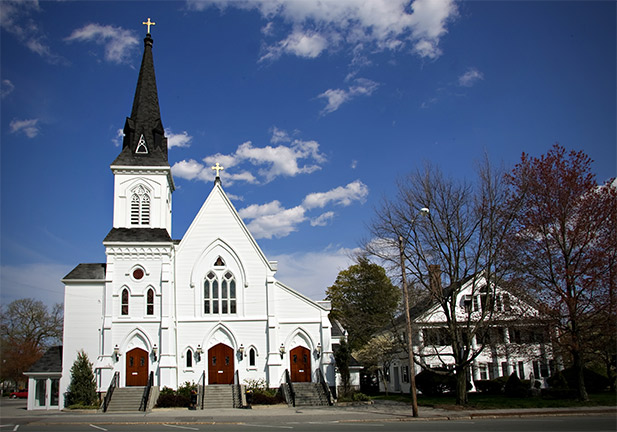
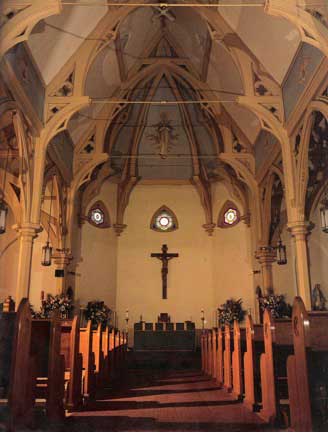
History 1800s
Dedication of the Church
St. Mary’s Religious Education Center
St. Mary’s Pipe Organ
St. Mary’s Celebrates its 100th Anniversary
St. Mary’s Pastors
Sr. Mary Ricci
Epilogue
HISTORY 1800S
The story of Saint Mary’s Parish is the story of the early Irish immigrants of 1840. They left their native land because of tyranny, want, and oppression. They looked forward to the land of promise and the home of the free. These people came without worldly possessions of gold and silver, but their youth, health and an ambition to better themselves was of more value. They had a sense of humor, hospitality and honesty… treasures not purchased with money.
In 1847, a branch of the Boston and Worcester rail road, which later became the Boston and Albany, had reached the center of Holliston. To make a deep cut through Phipps Hill at that time was an enormous task and required a great deal of time. To accomplish this task, these foreign strangers brought their strength and eagerness.
The pay was one dollar or one dollar and a quarter a day. The immigrants built rude cottages adjacent to the railroad, not far from the entrance to Pleasure Point. The earliest cottages were probably built on Arch Street. Much of this land was owned by Francis Cutler, William Thayer, and Abel Pond. Mr. Cutler gave this land to the town, and the cottages were built and sold to the immigrants.
The Irish settled down to a life of toil and self determination – men and women with courage to overcome the obstacles that beset their path. They cleared their land and prepared the lumber for their homes. With shovel, pick-axe wheel barrow, horse and tip cart, they built the railroad and the roads. The railroad was completed in 1848, and some of the Irish purchased farms or became farm laborers. Others worked in the growing industry in the manufacturing of boots.
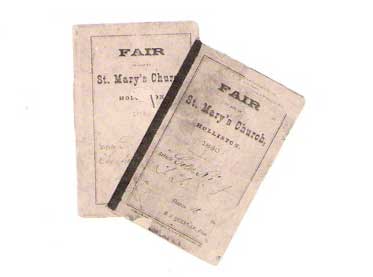
Before 1870:
As early as 1836, there is evidence that Catholics lived and worked in Holliston. These people, along with coreligionists from Milford, Hopkinton, Medway, Ashland, Upton, Marlborough, Maynard, Westborough, Cordaville, and Saxonville were visited by Fr. Tilton of Boston and later by Fr. Boyce of Worcester. These priests would periodically celebrate Mass in one of the towns and take care of the spiritual needs of their scattered flock.
In 1847, Fr. Boyce, along with a Fr. Gibson, instituted what is today St. Mary’s Parish in Milford. From this center, the priests would travel to the above named towns and say Mass regularly.
When and where the first Catholic Mass was held is conjectural. More than likely, Mass was celebrated in one of the homes of a leading citizen. For a number of years before St. Mary’s was formally established, however, Mass was celebrated in the old Town Hall. Local Catholics would assemble and Fr. Boyce or one of the other priests from Milford would hear confessions, baptize, and celebrate Mass. The Holliston community would be joined by people from as far away as Westborough, Bellingham, and Cordaville. Still other Catholics walked to Milford for Mass. Many people remember the walk to Mass, a distance of seven miles to St. Mary’s. It is remembered that on a Sunday morning as many as 75 to 80 people could be seen winding their way by the railroad track and road to worship. After its construction in 1851, the old St. Malachy (St. John’s) Church in Hopkinton, also attracted many Catholics from Holliston for their religious needs.
1870:
In December 1870, Holliston was named a district parish. It included Medway and Bellingham. Fr. Richard Quinlan was appointed the founding pastor.
Fr. Quinlan had a dream for Saint Mary’s church building: “…a simple church, extraordinary stain glass windows, and an organ second to none in the Archdiocese of Boston.” These dreams were realized over time. The construction of St. Mary’s was very slow because Fr. Quinlan was unwilling to incur a large debt.
St. Mary’s was centrally located in the principal part of town. There were wooden steps that gave access to three doors. The building was a frame structure, adapting the gothic architecture. The roof of the church had more pitch than churches of this style, generally. The narrow vestibule of the church opened to the interior’s three aisles, one in the nave and two on the sides. The pews, wainscoting, and altar railing were finished in quartered oak. The pillars, octagonal in shape, supported the wooden arches and arcades that also served as trusses for the roof. As the arches and arcades were not plastered, the customary gains were not so pronounced and the ceiling had few embellishments. The sanctuary was almost semi-circular in shape, frescoed in dark colors with gold trimmings. The portion from the floor to the altar was exceedingly dark with small gold dots, giving the appearance of brightly shining stars.
The trusses formed semi-arches between the painted religious symbols. There were three alcoves in the sanctuary with religious figures deposited in them. The original structure had two altars – the larger one being a mass of gold and bronze decorations which featured deep carvings that made it very attractive. The other altar, dedicated to the Blessed Virgin Mary, was situated on the right side of the sanctuary. Its decorations and carvings were exactly the same as the main altar, which enhanced the beauty and simplicity of the sanctuary. The same gothic effect was reinforced with an abundance of stained glass windows donated in memory of several parishioners by their families and friends.
DEDICATION OF THE CHURCH
Early in 1883, the Catholics of Holliston had one of their proudest moments. Priests and people from near and far gathered to dedicate their new church. Most Reverend Archbishop John Williams, with a retinue of priests, came to dedicate the church. It was consecrated to be the Home of God under the patronage of the Blessed Virgin Mary. The sermon for the occasion was delivered by Rev. Thomas Mclnnis, rector of St. Thomas Parish in Jamaica Plain.
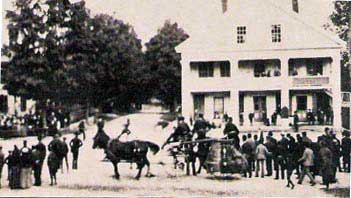
Holliston residents gather outside Town Hall on Washington and Elm Streets in front of the old Village Store. The store is now the site of St. Mary’s parking lot. This property was purchased, along with the rectory (not shown) by Fr. Quinlan shortly after the church was built in 1870.
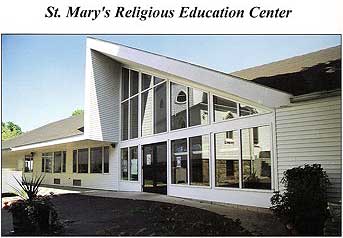
ST MARY’S RELIGIOUS EDUCATION CENTER
In the early years of the parish, Religious Education classes for St. Mary’s children were taught in the No. 8 Holliston School Building. After the completion of St. Mary’s church they were taught in the lower church, the rectory building purchased under Fr. Quinlan, and in a house owned by the parish.
Then in 1974, St. Mary’s received one of the greatest gifts in its history – a bequest from Mr. Fred R. Sullivan. Mr. Sullivan was a longtime resident of Holliston and a very successful businessman. He left over $900,000 to his parish for the purpose of erecting a Religious Education Center. Through his generosity a beautiful state-of-the-art educational center was built in his name.
The Religious Education Center was dedicated on September 23, 1979 with a concelebrated Mass with Humberto Cardinal Medeiros, followed by a banquet with Most Reverend Thomas V Daily, D.D., Chancellor of the Archdiocese as the guest speaker.
At the time of the dedication of the new Center, the total number of students enrolled in the religious education program was over a thousand. Mrs. Ginny Evans, a parishioner, was the first religious education coordinator during these years of unprecedented growth. Parishioners recall with fondness a commitment on the part of the parish staff to the new catechesis. The Bruzzleman program was introduced for First Eucharist. Sister Mary Lofgren, the first professional religious educator in the parish, was hired by Fr. Haley to succeed Mrs. Evans. She continued to develop the religious education program according to the modern catechetical movement.
ST. MARY’S PIPE ORGAN
Music has always been an important part of the liturgical life of St. Mary’s. Originally, there was a pipe organ installed in the church. There is no record, however, of the make or what happened to it. In 1978, Fr. Haley purchased the current organ at St. Mary’s. It was built by the Hutchings Votey Organ Company in 1905 for St. Mary’s Church in Southbridge. The people of Southbridge disposed of it in the early 1970s and it was found in a barn at the Laws Organ Company in Wenham, Massachusetts, where it was covered with dirt and in a million pieces. It was transferred to the barn at St. Mary’s where it sat while Fr. Haley negotiated with various organ builders, finally selecting Kinsey-Angestein Organ Company of Wrentham, Massachusetts.
This company went over every piece (1, 165 pipes alone), refurbishing and replacing where necessary. The whole instrument was assembled in their shop at Wrentham, then brought to St. Mary’s. The lovely wood case is the original 1905 wood, stripped, glued, and refinished. It is truly a beautiful sight in the loft.
The rebuilt Hutchings-Votey instrument is an encased mechanical action (tracker) pipe organ with two key-boards of 61 notes each and pedal with 30 notes. Both the key-playing action and the stop draw mechanism are mechanically operated. The organ has 17 registers of pipes and 21 ranks. This is because the Mixture on the Great Windchest has 4 ranks, or 4 pipes for each note. This is called a compound stop. The combining of unisons and fifths (much like the ancient Gregorian chant utilized) creates a tonal pattern which tops off the ensemble of stops for leading congregational singing.
In addition to the principals, flutes and strings, the organ has 3 solo stops. These are the trumpet, oboe, and the cornet. These stops can also be used with the other stops for added variety of tonal color. There are 1,165 pipes in the organ, ranging from 16″ to 1/16″ in length. Some of the pipes are of pine, although most are metal composed of 40% tin and 60% lead, something like pewter.
The dimensions of the organ case are approximately 15 feet wide by 9 feet deep by 15 feet tall.
The organ was dedicated on Friday, September 8, 1979 at 8:00 p.m. on the Feast of the Nativity of Mary.
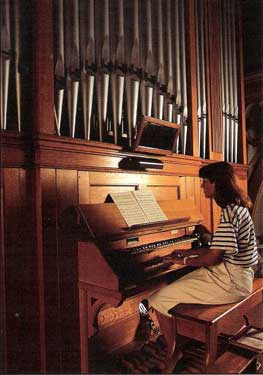
ST. MARY’S CELEBRATES ITS 100th ANNIVERSARY
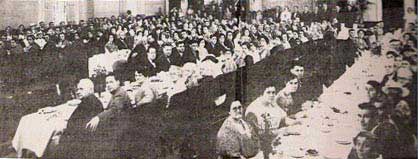
Archbishop Humberto Medeiros came to Holliston to celebrate the lOOth anniversary of the founding of the parish. It was the first Mass celebrated by the Cardinal outside Greater Boston since the new Archbishop was installed as the Archbishop of Boston. Nearly 500 people attended the Mass and the celebration that followed at Glen Ellen Country Club. Monsignor Kennedy, a native Hollistonian” gave the talk at the banquet describing growing up in Holliston and as a parishioner of St. Mary’s in the early days. A special cake shaped in the design of St. Mary’s Church was presented to a special table of older Parishioners, who were in the parish when it was founded. They were Mollie Curran. Anne King, Margaret Hamilton, Gladys Carey, Henry Carey, Grace Hoey, Anna Drennan, and Mary Clancy.
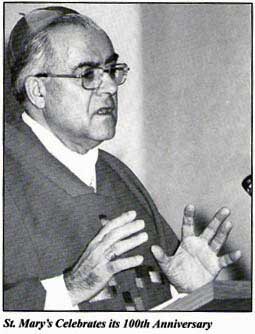
ST. MARY’S PASTORS
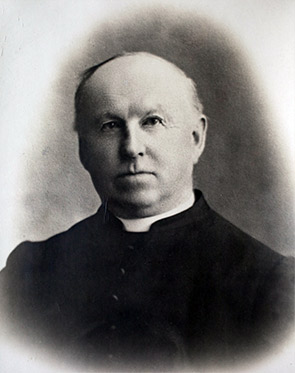
Fr. Richard Quinlan (1870-1912)
Fr. Quinlan was born in Boston on October 17, 1842, the only child of Patrick and Mary Quinlan. He grew up in North Easton and Pawtucket, Rhode Island, where he attended parochial schools. In 1857, Richard Quinlan entered Holy Cross College, graduated in 1863, then attended the Grand Seminary in Montreal, where he was ordained a priest on December 22, 1866. His first assignment was curate of St. James Church, Haverhill, Massachusetts. Shortly thereafter, he was transferred to St. Stephen’s Church in the North End of Boston. After four years there, Archbishop Williams assigned Fr. Quinlan to the Holliston district, which included Millis, Medway, Bellingham and Holliston. Fr. Quinlan remained pastor there for the rest of his life.
Fr. Quinlan celebrated his first Mass in Holliston at the Old Meeting House of the Universalist Society. This building previously had been purchased by Fr. Cuddihy in 1867. He adapted the worship space to fit Catholic liturgy. However, the Universalist Church was in such disrepair, Fr. Quinlan sold the building and it was moved. He began building the present St. Mary’s Church in 1870, meanwhile celebrating Mass in the old Town Hall. The first Mass was celebrated in the basement of the new church on Christmas, 1873. The rectory was bought shortly thereafter. Sunday school was held in No. 8 school building until the church was ready.
Fr. Quinlan was a quiet and easy going person. The parishioners found him very easy to approach with problems. He loved the people of Holliston and was respected both by the Catholic and Non-catholic citizens in Holliston. He had a number of opportunities to move to a larger parish, but declined all of them to remain in Holliston. He served on the school committee and was a member of the board of trustees of the Holliston Public Library. On December 22, 1886, Fr. Quinlan celebrated his silver jubilee of priesthood with a Solemn High Mass followed by a banquet and reception.
In the last four years of his life, he was in poor health but continued to celebrate Mass up to four days before his death. He died peacefully in the rectory on March 21 1912 after service as a pastor of St Mary’s for 42 years. His funeral Mass was celebrated on Wednesday with a large crowd, including many dignitaries from the diocese and town.
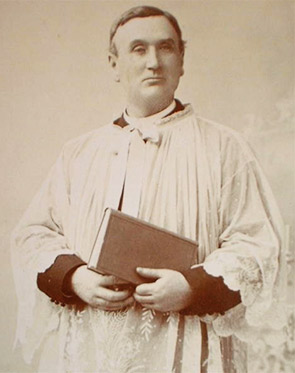
Fr. John Lyons (1912-1917)
Rev. John H. Lyons of St. Vincent’s Church in South Boston was appointed pastor of St. Mary’s in April of 1912. He continued the ministry of Fr. Quinlan, and was very interested in enlarging the church property. He purchased a former store on Elm and Washington streets. He razed the building and beautifully enhanced the property. Although his stay at Holliston was brief, he impacted the community in many ways.
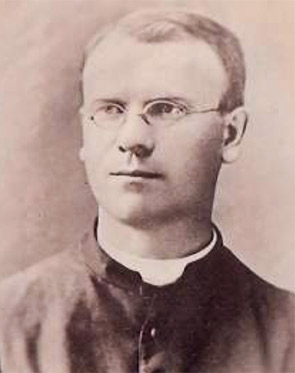
Fr. Andrew Fitzgerald (1917-1928)
In April of 1917, Fr. Lyons was transferred to St. Bridget’s in Abington, and was succeeded by Rev. Andrew Fitzgerald, who, in many ways, is considered the second founder of St. Mary’s. He ministered during World War I, when many of the young men from Holliston were called to serve their country. He ministered sympathetically to them and their families. Likewise, he was very interested in developing a first-rate religious education program, and spared no effort to recruit good teachers.
Father Fitzgerald was born in County Kerry, Ireland. He was educated and ordained to the priesthood at Maynooth College in Ireland. Older parishioners of St. Mary’s recall their parents and grandparents praising Fr. Fitzgerald a great preacher and conversationalist. He was able to discuss any topic, education, philosophical, religious, or social, with rare ability.
Despite ill health, Fr. Fitzgerald remained active and faithful to his pastoral responsibilities. Whenever duty called him to deathbed in the dead of night, Fr. Fitzgerald would be there. He gave of himself totally and unselfishly to the people of St. Mary’s. He died at Framingham Hospital on August 8, 1928 of a ruptured appendix. In reporting his death, the Framingham News reported “Holliston has lost a noble citizen.” His death was a loss not only to St. Mary’s but to the town of Holliston.
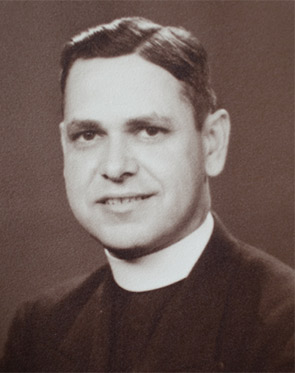
Fr. Patrick Lyons (1928-1933)
Rev Patrick Lyons succeeded Fr. Fitzgerald as pastor of St. Mary’s. Fr. Lyons was the former chaplain at Carney Hospital in Boston. Fr. Lyons undertook a number of projects during this brief pastorate. He renovated the church and rectory. He fixed the church hall so that it could be used for social gatherings and religious education. He purchased a new bell for the church, which called the parish to Liturgies and other activities. He built a new road into the cemetery and lined it with many trees. Likewise, he landscaped both the church and rectory.
Not content to improve the church physically, Fr. Lyons continued the tradition of fine religious education program at St. Mary’s. It was Fr. Lyons who invited the sisters of St. Joseph to minister to the educational needs of the children of the parish. A tradition that lasted well into the ’60s. Likewise, it was Fr. Lyons who established a chapter of the Massachusetts Catholic Women’s Guild at St. Mary’s, an organization that still flourishes today. Fr. Lyons’ ministry came to an end with his death from pneumonia at the rectory in November, 1933.
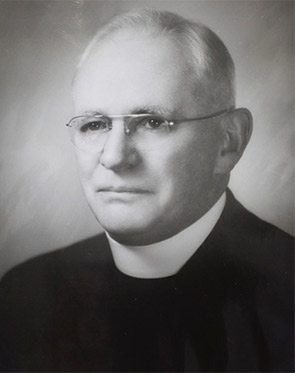
Fr. Henry Reardon (1933-1938)
Fr. Lyons’ successor came from the Blessed Sacrament Church in Jamaica Plain. Fr. Henry C. Reardon became pastor in December 1933. He found the parish in excellent shape both physically and spiritually. However, it was during his watch that the depression occurred. He assisted his parishioners with parish resources, comforted them in their pain, and reached out to all. He was a great comfort to the parish family during these difficult years.
In September, 1938, the famous hurricane occurred. St. Mary’s remained intact, however, the slate on the roof was ripped off in many places and the chimney from both church and rectory were destroyed. Following repairs of this damage, Fr. Reardon was called to minister to St. John’s Church in Wellesley Hills, Massachusetts.
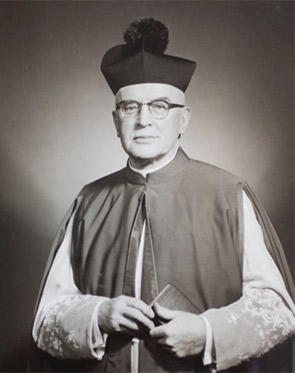
Fr. Cornelius J. Donovan (1938-1943)
Rev Cornelius J. Donovan of St. Philip’s Church in Boston succeeded Fr. Reardon as pastor of St. Mary’s. During his pastorate, he took special care of the youth of the parish. He was familiar and very interested in the national Catholic Youth Organization, a branch of which he established at St. Mary’s, known as the St. Mary’s Boys Club. Likewise, he was the first to establish a high school of religious education for the high school students. In cooperation with the school committee in town, the students would be released during the school day and report to St. Mary’s for the study of religion. These classes were held at St. Mary’s church hall. In 1943, Fr. Donovan was transferred to St. Monica’s Church in South Boston.
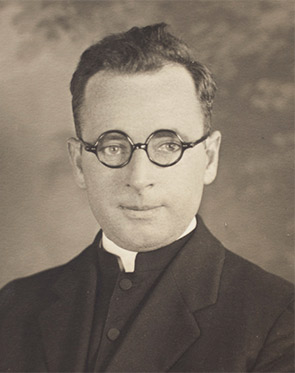
Fr. Daniel O’ Keefe (1943-1945)
Rev Daniel O’ Keefe came to St. Mary’s as its seventh pastor in 1943. His ministry at St. Mary’s spanned the Second World War. Most of the young men from St. Mary’s were serving their country in various parts of the world. During the war, Father O’ Keefe’s personality and caring manner was great solace to the families of the men in the armed forces. At the end of the war, Father Donovan was transferred to Billerica as the founding pastor of a new parish.
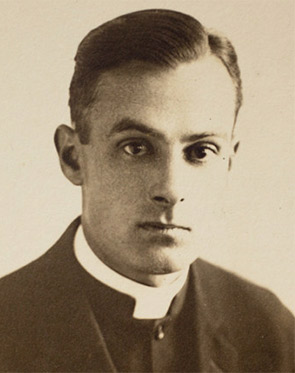
Fr. Leo O’ Leary (1945-1948)
Father Leo O’ Leary was the pastor of St. Mary’s as it celebrated its seventy-fifth anniversary. The commentators of the anniversary proffered that while in its first seventy five years, St. Mary’s was still a country parish. It did much good for the town of Holliston. It never grew because of the lack of industrial development of the region. The people of St Mary’s have always demonstrated a love for the parish, and a number of parishioners have distinguished themselves in diverse professions. Ten young men entered the priesthood from St. Mary’s and three women entered religious life.
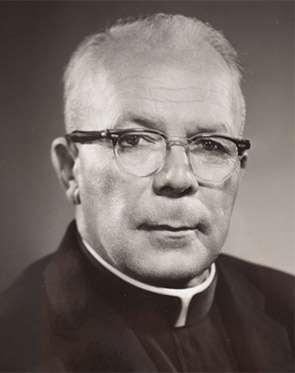
Fr. John Johnson (1948-1953)
The pastoral tenure of Fr. Johnson, Fr. Tobin, and Fr. Earl Lyons is remarkably similar. Father Johnson was born in South Boston and was ordained in Rome on June 14, 1924. After serving successfully as an associate pastor of a number of parishes in Forest Hills, St. Joseph’s in Belmont, and as a chaplain in the United States Army during World War II, Fr. Johnson assumed his pastorate at St. Mary’s. In 1953, he became pastor of Corpus Christi Church in Newton and passed away on October 31, 1961.
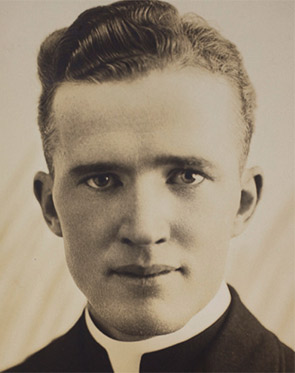
Fr. Thomas Tobin (1953-1963)
Father Thomas Tobin was born in Boston on March 24, 1902, and was ordained at Holy Cross Cathedral on April 5, 1929 by Cardinal O’ Connell. Likewise, Father Tobin served as an associate-pastor in over twenty parishes in the Archdiocese before assuming his pastoral duties as Pastor at St. Mary’s in November of 1953. He remained pastor for ten years, subsequently become pastor of St. Mary of the Annunciation in Danvers, Massachusetts. He died in Danvers on July 2, 1967.
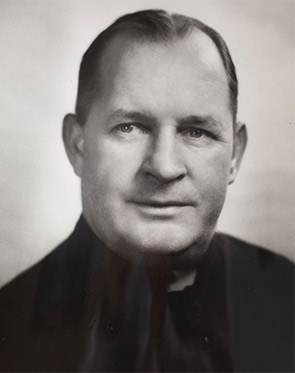
Fr. Earl Lyons (1963-1966)
Father Earl Lyons was born in Brighton, Massachusetts and was ordained on April 5, 1929 at Holy Cross Cathedral by Cardinal O’ Connell. He came to Holliston from the Parish of St. Mary of the Assumption in Dracut in 1963 and remained in Holliston for three years until Father O’ Brien’s appointment. Father Lyons died on January 23, 1969.
These were quiet but very happy years at St. Mary’s. Many of our adults, who grew up in St Mary’s, recall the tenure of these pastors. It was during this time that St. Mary’s provided many athletic and social events for the young people of the parish. There were baseball and basketball teams under the aegis of the Catholic Youth Organization. Long before the Vatican II, there was a cooperative spirit between St. Mary’s and the Congregational Church. Rev Sangree, a pastor of the First Congregational Church recalled how the youth group of his church was invited to the program of the Catholic Youth Organization.
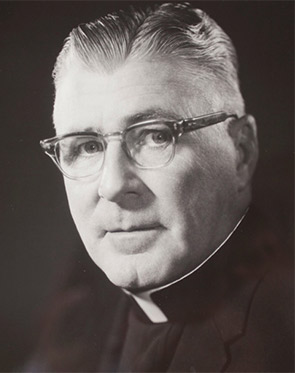
Fr. William O’ Brien (1966-1979)
Father O’ Brien was ordained on December 17, 1937 at the Cathedral of the Holy Cross. He served as an associate pastor of St. Theresa’s Parish in Revere until entering the Army Chaplain Corps during World War II.
Shortly after the war, he was assigned as Chaplain at the Boston Sanatorium and resided at St. Gregory Parish in Dorchester until his appointment as associate pastor at St. John the Evangelist Parish in Wellesley. These were followed by two additional assignments as associate pastor at St. Joseph in Roxbury and St. Monica in South Boston.
In 1966, Fr. O’ Brien was appointed pastor of St. Mary’s by Cardinal Cushing, where he served for thirteen years. It was during the tenure of Father O’ Brien that St. Mary’s experienced an unprecedented growth.
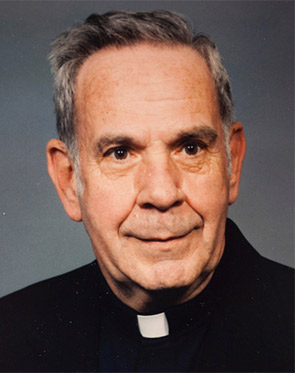
Fr. Patrick Kelly, Administrator (1972-1975)
Father O’ Brien was assisted by two administrators, Father Patrick Kelly and Father William Haley. Father Kelly was appointed a Chaplain in the United States Navy. His tours of duty included Hong Kong, Japan, Philippine Islands, and a Fleet Chaplain with the responsibility of spiritual guidance for the seamen aboard twenty-five ships. Father Kelly held the rank of Full Commander in the Navy. In 1964, Father Kelly was an associate pastor of St. Mary’s in Danvers, Massachusetts, when he was transferred to St. Mary’s, as Administrator. In addition to giving spiritual guidance to all parishioners, his many accomplishments at St. Mary’s included installation of the carillon (bell chimes) and serving as founder and advisor to the Mr. and Mrs. Club. In addition, he participated in the Holliston 250th Anniversary program, as well as being active in local ecumenical programs. In 1975, he was named Pastor of St. Mary’s in Lynn, Massachusetts.
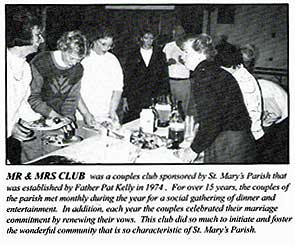
MR & MRS CLUB was a couples club sponsored by St. Mary’s Parish that was established by Father Pat Kelly in 1974. For over I S years, the couples of the parish met monthly during the year for a social gathering of dinner and entertainment. In addition, each year the couples celebrated their marriage commitment by renewing their vows. This club did so much to initiate and foster the wonderful community that is so characteristic of St. Mary’s Parish.
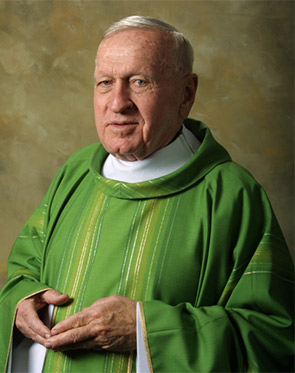
Fr. William J. Haley, Administrator (1975-1979), Pastor (1979-2005)
In 1975, Father William Haley was appointed administrator of St. Mary’s and remained administrator until the retirement of Father O’ Brien in 1979, at which time he assumed the duties as 13th pastor of St. Mary’s. Father Haley was born in Hull, Massachusetts on October 20, 1927. He attended Boston College High School in 1945, he attended St. Clements Hall, and then to St. John’s Seminary. He was ordained by Cardinal Cushing on January 10, 1952. His first parish assignment was at Our Lady of Mt. Carmel in Waterbury, Connecticut, then to St. Ambrose in Dorchester, Massachusetts. He enlisted in the United States Air Force and became lieutenant colonel. His tour of duty included Italy, Alaska, and Okinawa. When he left the service, he became associate pastor at St. Catherine’s in Norwood and remained there until his appointment to St. Mary’s.
When Father Haley assumed the pastorate, he found the parish ready to welcome him and his expertise. Again, St. Mary’s was given another gifted pastor. He finalized the planning and construction of the new religious education center, and continued to integrate the spirit of Vatican II into parish life. His leadership qualities were very evident. Father Haley began the interior renovation of the church with new doors for the entrance of the church, new flooring, new pews, a beautiful crucifix overlooking the sanctuary, a new tabernacle, and baptismal font. In all this, Father Haley was fulfilling the requirements of the liturgical decrees of Vatican II, and simplified the worship space.
In 1995 Father Haley oversaw the expansion of the St. Mary’s Church building by 200 seats. This was considered necessary for two reasons. First, St. Mary’s was continuing to grow and more people meant more space was needed. Secondly, a steady decline in the number of Catholic priests meant that in the future St. Mary’s might have only a single priest to serve its people. In such a case, it would be necessary to have less Masses but within a building that could now accommodate more people at each Mass. St. Mary’s expanded seating capacity was accomplished by adding two new transept wings, the walls of which integrated some of the original stained glass windows. The church sanctuary was also entirely remodeled, including the addition of a massive skylight above the altar area. As part of this renovation, the church building and religious education center were also connected.
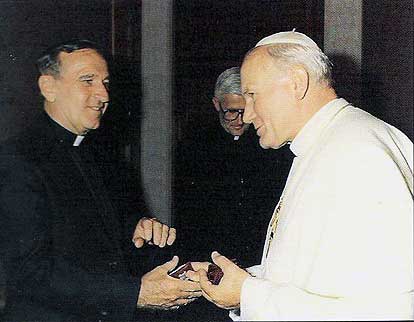
The second longest serving pastor of St. Mary’s, Father Haley left behind him much love and many happy memories. His long tenure gave him a wonderful familiarity with the people of the parish, as he was even able to marry parishioners he had baptized! Following his retirement in 2005, Fr. Haley lived in his family home in Hull, assisting part time at St. John’s Parish in Canton. Declining health then required him to move into the Regina Cleri Residence in Boston. Father Haley went home to God on Saturday, May 14, 2011; the Vigil of Good Shepherd Sunday. He is buried in St. Mary’s Cemetery, Holliston.
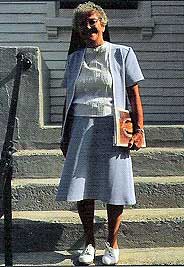
SR. MARY RICCI
A notable event in Fr. Haley’s pastorate was his hiring of Sister Mary Ricci, a member of the Sisters of St. Joseph. In September of 1980, she became St. Mary’s first Pastoral Associate. As a teaching sister of her order, Sister had dedicated many years to the education of young people. Her background and experience and her real sensitivity to the needs of individuals enabled her to give valuable assistance to the elderly, ill and housebound parishioners. Sister Ricci was known for her beaming smile, immense love, and the absolute delight she took in being a servant of God. As one parishioner put it, “I have observed Sister with the children and parents as they come for Religious Education. Not one person can escape her greeting and hug. Her enthusiasm for the children and her encouraging words for moms and dads uplift them all. Everyone leaves knowing God loves him or her, that each person is truly special in the eyes of God.” After her retirement in 2004, Sister Ricci lived with her Order at Bethany in Framingham. She went home to God on April 4, 2016. Sr. Ricci is buried in the Sisters of St. Joseph section of St. Stephen Cemetery in Framingham. “Jesus I love you and I trust you” was her favorite saying, and we know that now Sister’s trust in Jesus has been fulfilled, and her love made perfect in His Presence.
Rev. Mark J. Coiro (2005 – present)
Fr. Mark Coiro succeeded Fr. Haley as pastor of St. Mary’s in October of 2005. Fr. Mark is a 1990 graduate of St. Anselm College in Manchester New Hampshire, where he received his Bachelor’s Degree in Theology and Certification in Classics in 1990. He then attended St. John’s Seminary in Boston, receiving his Master of Divinity with a specialization in Systematic Theology in 1994.
While in seminary he joined the United States Army Reserve as a Chaplain Candidate, being commissioned a Lieutenant in the Staff Specialist Branch. In this capacity he served active duty tours at Fort Leonard Wood, MO; Letterman U.S. Army Hospital in San Francisco; and also with the 364th Armor Battalion in Schweinfurt, Germany.
On May 21, 1994 he was ordained a priest at the Cathedral of the Holy Cross in Boston. Fr. Mark said his First Mass of Thanksgiving at St. Clement’s Parish in Somerville, then served as Parochial Vicar in the Parishes of St. Theresa’s in Billerica, St. Jerome’s in N. Weymouth, and St. Joseph’s in Medway.
In October of 2005, Archbishop Sean O’ Malley ended Fr. Mark’s assignment as Parochial Vicar in Medway and named him as the fourteenth Pastor of St. Mary’s, Holliston.
Father Mark is always available to meet with parishioners to hear their ideas, needs, concerns, and dreams for St. Mary’s Parish.
The Xaverian Fathers
For much of its history, St. Mary’s has enjoyed a close relationship with the Xaverian Fathers. In 1940, on his way to Italy from the missions in China, Fr. Henry Frassineti, S.X. was stranded in the United States. Archbishop Cushing invited Father Frassineti to open a religious house in the Archdiocese. Fr. Frassineti purchased twenty acres of farm land, an abandoned farmhouse, and barn along Route 126. It was from these humble beginnings Our Lady of Fatima shrine became a reality. The shrine was dedicated on October 30, 1949 by Bishop Wright, and would become a popular pilgrimage place throughout the East Coast and Canada.
Since coming to Holliston, the Xaverian Fathers have always assisted the pastoral staff at St. Mary’s. Today they continue to celebrate some of St. Mary’s Masses, as well as providing confessors for the parish Religious Education program. St. Mary’s is truly blessed by the friendship and assistance of these holy men of God.
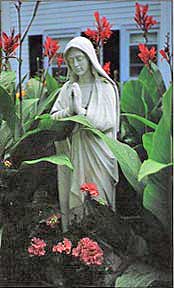
EPILOGUE
This historical perspective has been an effort to recapture those events that have, over a span of many years, caused St. Mary’s to grow from a small country parish to what it is today – one of the largest and most active Catholic parishes in the Archdiocese of Boston. While it has been essential to write more completely on the ministry associated with the Pastors, it must be remembered that their efforts would not have been blessed with such success had it not been for the invaluable work of the associate priests, and the people of St Mary’s.
It is not possible to describe the extent of the love of God that has been demonstrated so constantly and fully by St. Mary’s parishioners, who, through their prayers and sacrifices, have made our parish the vibrant faith community it is today. May they always be remembered in the prayers and good works by those of us who are the beneficiaries of their love.
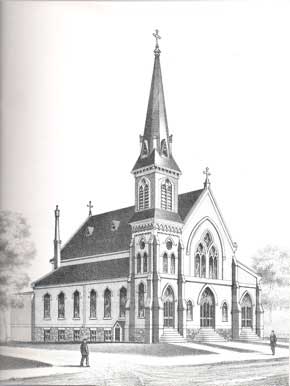
Thanksgiving After Mass and Holy Communion
From the very beginnings of Christianity the Church has given a special priority and attention to the Holy Mass over all other services because it is the one and only Sacrifice of the New Testament. In fact, in the Mass as the center and soul of liturgy, Christ offers Himself daily anew for each one of us. It is the infinite and immaculate oblation, the highest act of worship we can perform. Not the Priest alone offers this sacrifice, but with him all the faithful who attend, thus exercising the “royal priesthood” which St. Peter attributes to us. There is no greater action you could ever perform in your life than this cooperation in offering the Holy Sacrifice to the Heavenly Father.
The practice of making a proper Thanksgiving after Holy Communion should therefore be impressed. For generations, St. Mary’s has made a special point of teaching her people to give sufficient time to the prayerful union with Christ after having received Him. These few minutes following the reception of the Holy Eucharist are the most precious time of prayer we have.
At St. Mary’s, we have had a long-standing custom of making a short Thanksgiving together after Mass. It takes the form of all parishioners kneeling for a silent Hail Mary at then end of the Closing Hymn. When you accompany visitors to St. Mary s tell them about our custom, and ask them to share it with you. Wherever you may worship, always be sure to spend time in prayer with Jesus after receiving Him in Holy Communion.